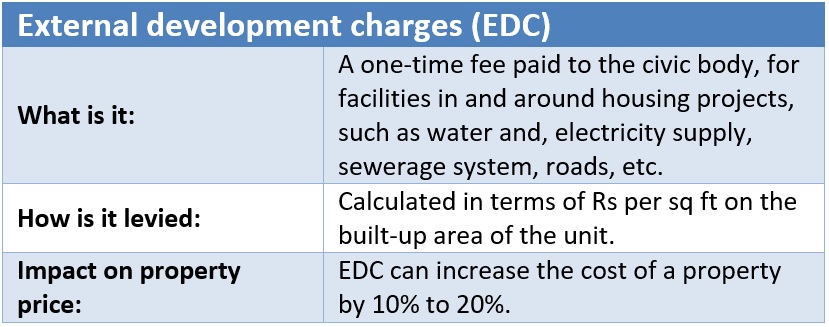The Silent Burden: A Deep Dive into External Development Charges
Jan 18, 2025

What Are External Development Charges (EDC)?
When you buy a home, you’re not just paying for the building or land. There are additional costs, like External Development Charges. EDC refers to the money developers pay to the local government for creating and maintaining civic amenities. These charges are mandatory, and their purpose is to build infrastructure like roads, water supply systems, and drainage facilities.
Why Do Developers Pay EDC?
Developers pay EDC to ensure the project has all the necessary facilities for its residents. Without these funds, basic services like water, electricity, and proper roads wouldn’t be available. However, while developers pay this fee upfront, the cost is eventually passed on to homebuyers.
Components Covered Under EDC
1. Roads
EDC ensures proper roads are built within the project. These roads make it easy for vehicles and pedestrians to move around. They also provide access to essential services like ambulances and garbage trucks.
2. Water Supply
Water is essential, and EDC covers the cost of pipelines, storage tanks, and pumps. This ensures all residents have a reliable supply of clean water.
3. Electricity
Electricity infrastructure, like transformers and substations, is expensive. EDC helps fund these systems, ensuring stable electricity for everyone in the project.
4. Landscaping
Beautiful parks, gardens, and playgrounds make a community more enjoyable. EDC funds the creation and maintenance of these spaces, adding to the overall appeal of the property.
5. Drainage and Sewage
Nobody wants to deal with waterlogging or sewage issues. EDC ensures proper drainage systems and sewage treatment plants are in place to keep the area clean and hygienic.
6. Waste Management
Proper waste disposal is critical for a clean environment. EDC covers systems like garbage collection points and recycling facilities.
How Does EDC Affect Homebuyers?
While EDC may sound like a developer’s responsibility, the reality is different. Developers include EDC in the property price. For homebuyers, this can increase the cost by 10-20%, depending on the region. For example, if you’re buying an apartment worth $100,000, you might end up paying an additional $10,000-$20,000 as part of EDC.
Difference Between EDC and IDC
Another term you might hear is Infrastructure Development Charges (IDC). While EDC focuses on facilities within the residential project, IDC is for broader infrastructure. IDC funds highways, bridges, and public transport systems that benefit entire regions. Both charges are separate but often included in the total project cost.
How Is EDC Calculated?
The calculation of EDC depends on the Floor Area Ratio (FAR) of the property. FAR is the ratio of a building’s total floor area to the size of the land. For example:
- If the FAR is 2 and the land area is 1,000 sq ft, the maximum floor area allowed is 2,000 sq ft.
- EDC per sq ft = Total EDC cost for the area ÷ Total permissible floor area.
Understanding FAR and EDC rates in your region can help you estimate this cost.
Penalties for Default in EDC Payment
If a developer fails to pay EDC on time, penalties are imposed. Fortunately, these penalties cannot be transferred to the homebuyer. This protects buyers from extra financial burdens caused by the developer’s non-compliance.
Regional Variations in EDC
EDC rates vary widely across cities and states. For example:
- In metropolitan areas like New York City, charges may be higher due to the need for extensive infrastructure.
- In smaller towns, EDC rates might be lower because the development needs are simpler.
These variations depend on local regulations and the level of infrastructure already available.
How to Check EDC Rates for Your Area
To find the EDC rates in your area, you can:
- Contact the developer for a detailed breakdown.
- Visit the website of your local planning authority or department.
Staying informed ensures there are no hidden surprises when you’re finalizing your property purchase.
Why Should Homebuyers Care About EDC?
Being aware of EDC helps you:
- Plan your budget better.
- Understand the true cost of your property.
- Ask developers the right questions about additional charges.
By staying informed, you can avoid unexpected costs and make smarter financial decisions.
Real-Life Example
Imagine a homebuyer named Sarah purchasing a 2,000 sq ft apartment in Texas. The base price of the apartment is $150,000. With an additional EDC rate of 15%, Sarah needs to budget an extra $22,500. By understanding this cost beforehand, she avoids financial strain and plans her purchase effectively.
Conclusion
External Development Charges (EDC) may seem complicated, but they are essential for creating a well-equipped residential community. By knowing what EDC covers, how it is calculated, and the regional variations, you can make better decisions when buying a property. Stay informed, ask questions, and plan your finances wisely for a smoother home-buying experience.
FAQs
1. What are External Development Charges (EDC)?
EDC refers to fees paid by developers to municipal authorities for infrastructure like roads, water, and electricity within a project.
2. How does EDC affect homebuyers?
The cost is added to the property price, increasing the overall expense by 10-20%.
3. How can I check EDC rates?
You can contact the developer or visit your local planning authority’s website for detailed rates.
4. What happens if a developer doesn’t pay EDC?
A penalty is imposed on the developer, but it cannot be transferred to homebuyers.
By staying proactive and understanding these charges, you can avoid surprises and enjoy a more confident home-buying journey.

